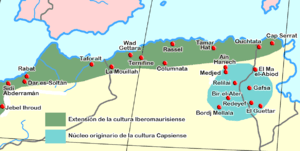Iberomaurusian

The Iberomaurusian culture is a backed bladelet lithic industry found throughout the Tamazgha.[1] The industry was originally described in 1909 by the French scholar Pallary, at the site of Abri Mouillah.[2] Other names for the industry have included "Mechta-Afalou", "Mouillian" and "Oranian".[3]
Recent fieldwork indicates that the Iberomaurusian culture existed in the region from around the timing of the Last Glacial Maximum (LGM), at 20,000 BP, until the Younger Dryas.[4] The industry is succeeded by the Capsian culture, which was originally thought to have spread into the Maghreb from the Near East.[5] However, later studies suggest that the Iberomaurusian may have been the progenitors of the Capsian.[6][7]
Although modern populations in the Maghreb speak languages belonging to the Afro-Asiatic family, which is associated with the Capsian culture, it has been hypothesized that the Capsians' predecessors, the Iberomaurusians, may have spoken a language(s) from a different phylum. This was inferred from the likelihood that the Iberomaurusians existed prior to the advent of the Proto-Afro-Asiatic language, as well as from the presence of what appears to be an older, pre-Afro-Asiatic population substratum in parts of the Atlas Mountains. Despite suggestions that this minor element may be related to the Basques of southwestern Europe, there appear to be no vestiges of a Basque linguistic influence in the region.[8]
Genetics
In 2013, Iberomaurusian skeletons from the prehistoric sites of Taforalt and Afalou were analyzed for ancient DNA. All of the specimens belonged to maternal clades associated with either North Africa or the northern and southern Mediterranean littoral, indicating gene flow between these areas since the Epipaleolithic.[9] The ancient Taforalt individuals carried the mtDNA Haplogroup N subclades like U6, H, JT and V, which points to population continuity in the region dating from the Iberomaurusian period.[10] In 2016 it has been identified mtDNA haplogroups H or U, T2b, JT or H14b1, J, J1c3f, H1, R0a1a, R0a2c, H2a1e1a, H2a2a1, H6a1a8, H14b1, U4a2b, U4c1, U6d3.[11]
A 2003 sequencing on the mitochondrial DNA of two Cro-Magnons (23,000-year-old Paglicci 52 and 24,720-year-old Paglicci 12) identified the mtDNA as Haplogroup N.[12]
See also
References
- ↑ Camps, G., 1974. Les Civilisations Préhistoriques de l'Afrique du Nord et du Sahara, Paris: Doin
- ↑ Pallary, P., 1909. Instructions pour la recherche préhistorique dans le Nord-Ouest de l'Afrique, Algiers.
- ↑ Balout, L., 1955. Préhistoire de l'Afrique du Nord, Paris: Arts et Métiers Graphiques
- ↑ Bouzouggar, A. et al., 2008. Reevaluating the Age of the Iberomaurusian in Morocco. African Archaeological Review, 25(1), pp.3–19
- ↑ Camps, G., 1974. Les Civilisations Préhistoriques de l'Afrique du Nord et du Sahara, Paris: Doin
- ↑ Lubell, D., Sheppard, P. & Jackes, M., 1984. Continuity in the Epipalaeolithic of North Africa with Emphasis on the Maghreb. Advances in World Archaeology, 3, pp.143–191
- ↑ Irish, J.D., 2000. The Iberomaurusian enigma: North African progenitor or dead end? Journal of Human Evolution, 39(4), pp.393–410
- ↑ Fleming, Harold (1965). The age-grading cultures of East Africa: an historical inquiry, Volume 2. University of Pittburgh. p. 348. Retrieved 15 May 2016.
- ↑ Kefi R, Bouzaid E, Stevanovitch A, Beraud-Colomb E. "MITOCHONDRIAL DNA AND PHYLOGENETIC ANALYSIS OF PREHISTORIC NORTH AFRICAN POPULATIONS" (PDF). ISABS. Archived from the original (PDF) on 11 March 2016. Retrieved 17 January 2016.
- ↑ Bernard Secher; Rosa Fregel; José M Larruga; Vicente M Cabrera; Phillip Endicott; José J Pestano & Ana M González. "The history of the North African mitochondrial DNA haplogroup U6 gene flow into the African, Eurasian and American continents". BMC Evolutionary Biology. Retrieved 26 January 2016.
- ↑ On the origin of Iberomaurusians: new data based on ancient mitochondrial DNA and phylogenetic analysis of Afalou and Taforalt populations, 2016.
- ↑ Caramelli, D; Lalueza-Fox, C; Vernesi, C; Lari, M; Casoli, A; Mallegni, F; Chiarelli, B; Dupanloup, I; Bertranpetit, J; Barbujani, G; Bertorelle, G (May 2003). "Evidence for a genetic discontinuity between Neandertals and 24,000-year-old anatomically modern Europeans". Proc. Natl. Acad. Sci. U.S.A. 100 (11): 6593–7. Bibcode:2003PNAS..100.6593C. PMC 164492
 . PMID 12743370. doi:10.1073/pnas.1130343100.
. PMID 12743370. doi:10.1073/pnas.1130343100.